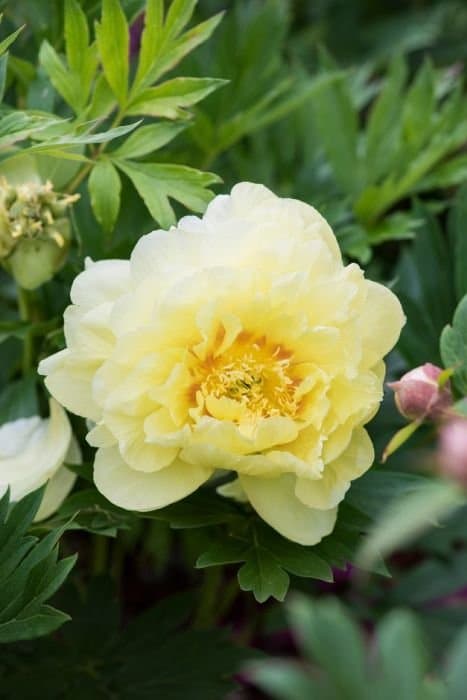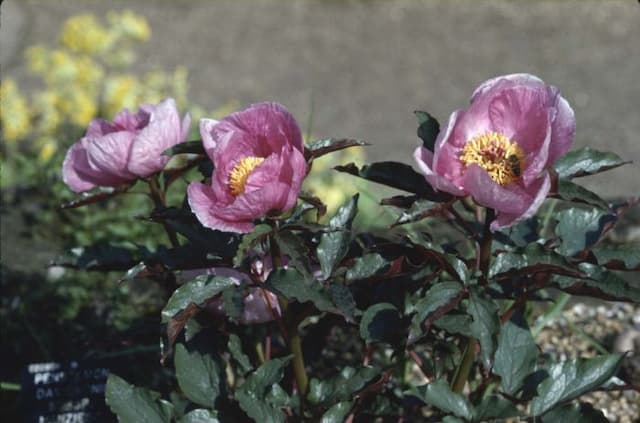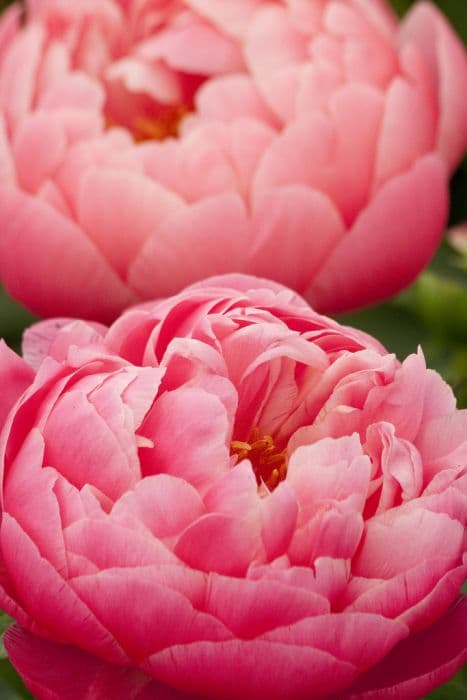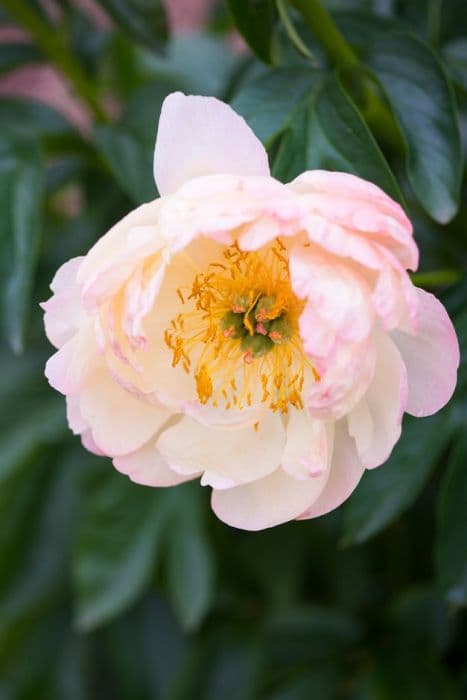European Peony Paeonia peregrina

ABOUT
The plant known by the name red peony is a perennial flowering plant that showcases a lush and vibrant appeal. It produces large, showy blossoms that are often a striking crimson red, although some varieties might have flowers in shades of pink or white. Each flower has numerous petals that are broad and slightly ruffled at their edges, surrounding a cluster of prominent golden-yellow stamens in the center that add a contrast to the deep petal colors. The leaves of the red peony are deep green, divided into multiple leaflets with a smooth or somewhat wavy margin. They grow in a dense, rounded shape, creating an attractive backdrop for the flowers. As the season progresses, the foliage remains robust, adding texture and color to the garden even when the plant is not in bloom. The red peony produces a substantial root system and can live for many years, contributing to a garden's beauty with both its foliage and its remarkable flowers. It is often prized for its ornamental qualities and is a favorite in many gardens and floral arrangements.
About this plant
 Names
NamesFamily
Paeoniaceae.
Synonyms
Red Peony, Balkan Peony, European Peony.
Common names
Paeonia corallina Retz., Paeonia decora Andrews, Paeonia humilis Host, Paeonia officinalis var. humilis (Host) Nyman, Paeonia paradoxa auct., Paeonia parnassica Tzanoud., Paeonia triternata Pourr.
 Toxicity
ToxicityTo humans
Paeonia peregrina, commonly known as peony, has compounds that may be toxic to humans if ingested. While it is primarily grown for ornamental purposes and rarely considered for consumption, ingestion of peony parts can lead to adverse effects. The plant contains a substance called paeonol, which can cause gastrointestinal upset, with possible symptoms including nausea, vomiting, and diarrhea. It is generally advisable to avoid eating any part of the peony plant.
To pets
Peony, the common name for Paeonia peregrina, is also considered toxic to pets. If pets, such as dogs or cats, ingest peony leaves, stems, or flowers, they may experience symptoms similar to those in humans, including vomiting, diarrhea, and, in severe cases, lethargy. The toxic principle in peonies can affect pets' gastrointestinal tract and nervous system. It's essential to keep these plants out of reach of pets and to seek veterinary care if ingestion is suspected.
 Characteristics
CharacteristicsLife cycle
Perennials
Foliage type
Deciduous
Color of leaves
Green
Flower color
Red
Height
2 feet (0.61 meters)
Spread
2 feet (0.61 meters)
Plant type
Herb
Hardiness zones
4
Native area
Mediterranean
Benefits
 General Benefits
General Benefits- Aesthetic appeal: Paeonia peregrina, commonly known as the Peony, has large, showy flowers that enhance the visual beauty of gardens and landscapes.
- Perennial growth: As a perennial plant, it returns yearly, offering long-term garden presence without needing to replant each season.
- Attracts pollinators: The blooms attract bees and other pollinators, which are essential for the health of many gardens and ecosystems.
- Cultural significance: Peonies have rich cultural associations, symbolizing prosperity, good luck, and happiness in some cultures, making them popular in celebratory occasions.
- Variety of colors: It comes in various colors, which provides options for gardeners to create diverse and colorful garden designs.
- Suitable for cut flowers: They make excellent cut flowers due to their large, fragrant blooms and long vase life, ideal for floral arrangements and bouquets.
 Medical Properties
Medical Properties- Anti-inflammatory: Paeonia peregrina may have compounds that help reduce inflammation in the body.
- Antispasmodic: The plant has been traditionally used to alleviate muscle spasms.
- Analgesic: There is traditional use of Paeonia peregrina for its pain-relieving properties.
- Immunomodulatory: Some research suggests peonies may have effects on the immune system.
 Air-purifying Qualities
Air-purifying QualitiesThis plant is not specifically known for air purifying qualities.
 Other Uses
Other Uses- Paeonia peregrina, commonly known as the red peony, is often used in perfumery; its distinct fragrance can be extracted for use in various perfumes and scented products.
- The petals of the red peony are sometimes used in the culinary world for their color, adding a vibrant red hue to salads and desserts when used as an edible garnish.
- In some cultures, the red peony's flowers and leaves are dried to be used in aromatic sachets, which are then placed in closets or drawers to impart a pleasant fragrance to linens and clothing.
- Red peony petals have been traditionally used to make natural dyes for clothing and textiles, providing a range of colors from light pinks to deep reds depending on the mordant used.
- The blooms of the plant are used in the art of flower arranging; red peony's bold colors and large blossoms make dramatic focal points in floral decorations.
- Gardeners might plant red peony as a companion plant, since it has been proposed to help deter certain pests from more vulnerable crops or plants nearby.
- Red peony seeds are sometimes incorporated into jewelry and craft projects as natural beads, providing an earthy aesthetic to handmade items.
- In landscape design, red peony is utilized for its striking appearance, serving as an ornamental plant that adds color and texture to garden beds and borders.
- The plant's woody stems can be harvested and used in basketry or as natural supports for other climbing plants in the garden.
- During certain festivals or celebrations, red peony flowers might be used in garlands or wreaths as a symbol of prosperity and honor in different cultures.
Interesting Facts
 Feng Shui
Feng ShuiThe Peony is not used in Feng Shui practice.
 Zodiac Sign Compitability
Zodiac Sign CompitabilityThe Peony is not used in astrology practice.
 Plant Symbolism
Plant Symbolism- Romance: Peonies, including Paeonia peregrina, are often associated with romantic love, possibly due to their lush, full blooms and rich fragrance.
- Prosperity: The full and rounded shape of peony blooms symbolizes abundance and wealth, making them a popular choice for celebrations and well-wishing.
- Honor and Nobility: In historical contexts, particularly in China, peonies have been associated with honor, high status, and nobility, since they were often found in the gardens of the wealthy and powerful.
- Beauty: Peonies symbolize the beauty in all forms, inspired by their own striking appearance and variety of colors.
- Bashfulness: According to one myth, nymphs were believed to hide within peony petals, which has led to the association of the flower with bashfulness or shyness.
- Happiness and Good Luck: Peonies are considered a good luck charm for happy marriages and good fortune, hence their popularity in wedding bouquets and decorations.
- Healing: Historically, peonies were used for their medicinal properties, symbolizing healing and the use of nature to improve health.
 Water
WaterThe common peony, Paeonia peregrina, should be watered deeply once a week during the growing season if there is no significant rainfall, allowing the soil to dry out between waterings. During the dormant season, watering can be reduced significantly. Generally, it's best to provide about an inch of water, which equates to roughly 0.6 gallons for an area of one square foot, each time you water. Do not water the foliage directly to avoid fungal diseases, but rather aim for the base of the plant.
 Light
LightPeonies such as Paeonia peregrina thrive in full sun conditions, which means they should receive at least 6 hours of direct sunlight daily. They can tolerate light partial shade, but too much shade can reduce blooming. The best spot for a peony is an area that's bright and sunny with some protection from harsh afternoon sun in extremely hot climates.
 Temperature
TemperaturePeonies like Paeonia peregrina are hardy and can tolerate a wide range of temperatures, but they prefer temperate climates. They can survive winter chill down to about -20 degrees Fahrenheit and are comfortable in summer temperatures up to 80 degrees Fahrenheit. For optimal growth and blooming, aim to keep your peony in an environment that stays within 65 to 75 degrees Fahrenheit.
 Pruning
PruningPeonies like Paeonia peregrina require minimal pruning which is generally done to remove spent flowers or deadhead, and tidying up the plant in fall. Cut back the foliage to the ground in autumn after the leaves have died back. This helps prevent disease and prepares the plant for winter.
 Cleaning
CleaningAs needed
 Soil
SoilThe best soil mix for Peony (Paeonia peregrina) should be fertile, well-draining, and have a neutral to slightly alkaline pH of 6.5 to 7.5. A mix of garden soil, compost, and perlite or vermiculite can create an ideal environment for root growth. It is important to ensure good soil structure to prevent waterlogging.
 Repotting
RepottingPeonies, including Paeonia peregrina, are not commonly repotted as they prefer to be left undisturbed. However, if necessary, repotting should be done in the fall, and typically peonies can be divided every 10 to 15 years or when they become overcrowded.
 Humidity & Misting
Humidity & MistingPeonies, such as Paeonia peregrina, are tolerant of a wide range of humidity levels and do not require high humidity. They thrive in the outdoor environment where the natural atmospheric humidity is generally sufficient for their growth.
 Suitable locations
Suitable locationsIndoor
Ensure ample sunlight, cool temperatures, and well-draining soil.
Outdoor
Plant in full sun, well-draining soil, and provide winter mulch.
Hardiness zone
4-8 USDA
 Life cycle
Life cyclePaeonia peregrina, commonly known as the Balkan peony, begins its life as a seed planted in well-drained soil, ideally in autumn. The seed undergoes stratification through the winter months, requiring a period of cold to break its dormancy. In spring, the seed germinates and a young shoot emerges, developing into a small herbaceous plant with characteristic deeply lobed leaves. As the plant matures, it forms an underground tuberous rootstock that allows it to survive as a perennial. Once the Balkan peony reaches maturity after a few years, it blooms in late spring to early summer, producing large, showy red or pink flowers that are attractive to pollinators. After flowering, the plant goes into senescence, with above-ground parts dying back to the ground in autumn, and enters dormancy over winter, relying on its rootstock to regenerate the following spring.
 Propogation
PropogationPropogation time
Spring-Early Summer
For the Paeonia peregrina, commonly known as the European peony, propagation is most commonly done by dividing the roots, ideally in the fall after the leaves have died back, which gives the new plant time to establish itself before the onset of winter. Carefully dig up the peony clump and rinse off the dirt to reveal the structure of the roots. Look for healthy sections of root that have at least three to five eyes, which are small reddish buds where new growth will emerge. Using a sharp knife, cut the roots into sections, ensuring each piece has a sufficient number of eyes. These divisions should then be planted in well-drained soil at a depth where the eyes are no more than 2 inches (5 cm) below the soil surface to ensure proper growth. IHttpActionResult









